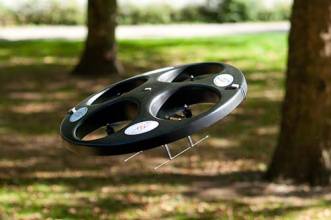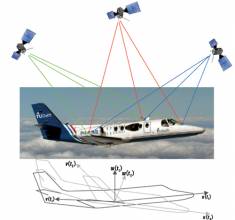This article describes an integration of a single-frequency GNSS, two-antenna heading system with low-cost inertial and magnetic field sensors in order to improve the availability and reliability of pure GNSS attitude determination. This method calculates a redundant attitude solution in an error-state Kalman filter using different sensor setups. As a result, the process of carrier phase ambiguity resolution accelerates.
This article describes an integration of a single-frequency GNSS, two-antenna heading system with low-cost inertial and magnetic field sensors in order to improve the availability and reliability of pure GNSS attitude determination. This method calculates a redundant attitude solution in an error-state Kalman filter using different sensor setups. As a result, the process of carrier phase ambiguity resolution accelerates.
Our approach exploits the known baseline length and an estimation of the inertial yaw and pitch angles are exploited in an extension of the LAMBDA method for a significant reduction in the ambiguity search. This not only reduces the time to first fix (TTFF) but also increases the reliability of the fixed ambiguities. With regard to small-sized and portable launcher applications, we emphasize a leveled system structure and short baseline lengths of up to 20 centimeters.
Measurement results demonstrate that our system enables single-epoch ambiguity resolution. The existence of the precise GNSS heading information facilitates an online calibration of magnetic field sensors. In turn, a calibrated magnetic field sensor enables the recovering of heading information during GNSS outages without any loss of accuracy.
The Challenge of Attitude Determination
Determination of horizontal attitude poses a general problem for navigation applications. Whereas roll and pitch angles can be calculated from accelerometer measurements of the gravity vector, the yaw angle is poorly observable, especially during periods of low platform dynamics. Aiding with a magnetic field sensor is possible, but such measurements suffer from systematic magnetic deviation errors.
A GNSS compass, however, provides attitude information unafflicted by any systematic offset errors. With an array of at least three antennas, the entire orientation of the antenna structure can be determined. The necessary accuracy, even for short antenna baselines in the sub-meter range, is gained by carrier phase processing. However, this entails additional complexity due to the required resolution of carrier phase ambiguities.
A widespread technique to identify carrier phase ambiguities is the LAMBDA (Least-squares AMBiguity Decorrelation Adjustment) method described in the article by P. Teunissen listed in the Additional Resources section near the end of this article.). Using a floating estimation of the ambiguities and the corresponding variance matrix, we can solve the integer least-squares problem in a very efficient way, achieving dual-frequency data resolution within a few observation epochs. However, real-time ambiguity resolution based on data from low-cost, single-frequency GNSS receivers is not readily possible.
Employing relative positioning, however, introduces new opportunities because additional information can be provided. A reduction of the ambiguity search space is accomplished by accounting for the known baseline length (For details, see the articles by P. Clark et alia and R. Mönikes et alia 2005 listed in Additional Resources). As a result, real-time resolution of double-differenced ambiguities from single-frequency data is possible.
For a further acceleration of the ambiguity identification process, an extension of the LAMBDA algorithm has been proposed (Mönikes et alia 2007) to enable a seamless integration of yaw and pitch angle constraints in the LAMBDA method, which in turn yields an additional shortening of the time to first fix.
In this article, we describe our combination of a single-frequency GNSS compass with low-cost inertial and magnetic field sensors to test this approach. With regard to launcher applications where leveled system alignment can be assured, we use a two-antenna system with a fixed baseline length of 20 centimeters. Hence, the GNSS attitude solution only consists of heading (yaw angle) and elevation (pitch angle) information.
Using inertial sensor data, redundant attitude estimation is carried out in an error-state Kalman filter which can be exploited as yaw and pitch angle constraints in the Extended LAMBDA method proposed by Mönikes et alia. Besides the reduction in the time to first fix, another benefit accrues from the creation of a redundant attitude solution. Where a pure GNSS attitude system would fail during signal outages, the redundant inertial attitude could bridge short periods of time and therefore form a more reliable attitude determination system.
In the next section, we briefly introduce the algorithmic basis of our system, namely the Extended LAMBDA method. Thereafter, we present the inertial attitude filter with its system and measurement models. Subsequent discussion illustrates the fusion of both independent attitude determination systems is illustrated. After presenting test results, we will describe possible system refinements, including aspects of integrity monitoring and an online calibration of the magnetic field sensor.
Extended LAMBDA Method
With measurements from two receivers and creation of wide-lane combinations, the LAMBDA algorithm can provide ambiguity resolution within a few epochs. However, for L1 carrier phase measurements with its short wavelength of 19 centimeters, instantaneous ambiguity fixing cannot be accomplished by the original LAMBDA method. As mentioned earlier, Mönikes et alia proposed one possible solution in a 2005 article by introducing an advancement of the LAMBDA algorithm for relative positioning.
For a fixed system structure the baseline length can be assumed as known. Furthermore, some GNSS compass applications allow for restrictions concerning potential attitude angles. For example, expected pitch angles for ships or trains are small. The Extended LAMBDA method enables one to account for constraints with the aim of a further reduction in the ambiguity search space. In other words, we only investigate those combinations of ambiguities leading to a base vector consistent with the constraints.
. . .
Yaw and Pitch Angle Constraints. The formulation of an equation for attitude angle constraints is based on the orthogonal projection of the normalized base vector.
. . .
Inertial Attitude Filtering
While it is conceivable to assume a static pitch angle constraint for some applications (e.g., ships and trains), utilizing yaw angle constraints are only realizable with external sensor information. For this purpose, we designed an inertial attitude determination system consisting of gyroscopes, accelerometers, and a magnetic field sensor.
. . .
Inertial Sensor Setup
Addressing economic concerns, a reduction of inertial sensors would be possible depending on the application . . . With a two-antenna GNSS compass, the roll angle is not observable. Nevertheless, for launcher applications, a two-antenna system is suitable since the roll angle is not necessarily of interest. In this case, the calculation of roll angles, and therefore the gyroscope in body-x direction, become dispensable. Furthermore, using tripods makes possible a system structure alignment with a roll angle of zero degrees. Consequently, we expect no influence of the gravity vector on the body-y accelerometer measurement, which makes the corresponding sensor dispensable.
. . .
Multi-Sensor Compass
The fusion of the GNSS two-antenna system and the inertial attitude filter forms a coherent multi-sensor compass. Such a system has an increased availability and reliability compared to a pure GNSS compass as the inertial attitude information is used to reduce the ambiguity search space. Moreover, the newly formed compass is able to provide attitude information during GNSS signal outages.
. . .
Measurement Results
In order to evaluate the performance of our system, several measurement campaigns were carried out on the roof of the Institute of Systems Optimization, Karlsruhe.
. . .
Time to First Fix. In the first static test, a baseline length of 20 centimeters was used and the construction was approximately horizontally aligned. During a measurement campaign of 15 minutes, inertial data, and GNSS raw data were logged. During this initial time period, the GNSS compass was not rotated. We used offline processing to investigate the time to first fix (TTFF). In order to gain statistically sustainable results, a new filter was started with every GNSS epoch (one hertz) and the corresponding TTFF, recorded.
. . .
Accuracy. Besides the capability of ambiguity fixing, the most important quality indicator for our system is the achievable heading accuracy. The major advantage of a GNSS heading system compared to an inertial system is that we should expect no offset. Hence, the accuracy of GNSS heading information can be assessed by static measurements. In principle, the accuracy decreases with smaller baseline lengths as errors in the estimated base vector yield larger attitude errors.
. . .
Model Refinements
Since a yaw angle aiding with accelerometer measurements is not possible, the accuracy of inertial yaw angle estimation depends on the quality of measurements from the magnetic field sensor. The integrity of those measurements, however, strongly depends on environmental conditions.
As can be seen from the plot in Figure 6, GNSS provides a much more reliable yaw angle solution. Hence, it is reasonable to replace the magnetic field measurement aiding for horizontal attitude with the GNSS yaw angle solution whenever available. Consequently, the magnetic field sensor is only required during GNSS outages.
Online Calibration of the Magnetic Field Sensor. In order to calibrate the magnetic field sensor, reference heading information is necessary. Thus, accomplishing an online calibration of the magnetic field sensor is possible as long as GNSS heading information is available. A way to do this is by modeling errors as bias and scale factors and computing them in an estimation process.
. . .
Integrity Monitoring. Due to the stochastic nature of measurement errors, incorrect fixes can never be completely excluded. On the basis of residual integrity monitoring, the detection of errors is only possible after several minutes when the direction to satellites has measurably changed. Additionally, false alarm should be avoided as no reliable GNSS solution is provided during the period of ambiguity fixing.
This article demonstrates that the time to first fix is greatly reduced by using the Extended LAMBDA method and constraints based on redundant attitude information. This enables a more sensitive integrity monitoring, because an immediate ambiguity fix is guaranteed.
Our method also provides new measurements for monitoring, namely, the given baseline length and the redundant attitude information. Therefore, in addition to the residual cycle slip detection for carrier phase measurements, a verification of the GNSS attitude solution based on fixed ambiguities is carried out. If the estimated baseline length differs more than 10 percent from the given baseline length, the current fix is rejected. The same applies for large deviations of GNSS attitude from inertial attitude.
Conclusions
In this article, a multi-sensor attitude system for portable, small-sized launcher applications was described. Accelerometers, gyroscopes, and a magnetic field sensor were combined with a GNSS compass. By using an extension of the LAMBDA method which accounts for baseline length and attitude constraints, an ambiguity resolution within a few epochs is guaranteed. The required redundant attitude information originates from a Kalman filter estimation based on inertial and magnetic field measurements.
The reduction of the ambiguity search space caused by exploiting attitude constraints not only results in shortening the time to first fix but also increases the reliability of the ambiguity resolution. Furthermore, the availability of a redundant attitude solution enables bridging GNSS dropouts and enhanced integrity monitoring.
In order to improve the pure inertial attitude quality, an online calibration of the magnetic field sensor was implemented. The measurement results show that even for the short baseline length of 20 centimeters the maximum error of yaw angles is less than two degrees with a standard deviation of less than one degree.
Acknowledgment
This article is based on a paper presented at the 2012 ION International Technical Meeting.
For the complete story, including figures, graphs, and images, please download the PDF of the article, above.
Additional Resources
[1] Mönikes, R., and J. Wendel, J. and G. F. Trommer, “A Modified LAMBDA Method for Ambiguity Resolution in the Presence of Position Domain Constraints,” Proceedings of the 18th International Technical Meeting of the Satellite Division of The Institute of Navigation, pages 81-87, 2005
[2] Mönikes, R., and O. Meister, J. Wendel, and G. F. Trommer, “Yaw Angle Estimation of VTOL-UAVs with the Extended LAMBDA Method and Low Cost Receivers,” Proceedings of the 2007 National Technical Meeting of The Institute of Navigation, pages 179-186, 2007
[3] National Oceanic and Atmospheric Administration (NOAA): World Magnetic Modell (WMM), 2010
[4] Park, C., and P. Teunissen, “A New Carrier Phase Ambiguity Estimation for GNSS Attitude Determination Systems.” Proceeding of International Symposium on GPS/GNSS, Tokyo, pages 283-290, 2003
[5] Teunissen, P., “The Least-Squares Ambiguity Decorrelation Adjustment: A Method for Fast GPS Integer Ambiguity Estimation,” Journal of Geodesy, Vol. 70, No. 1, pp. 65-82, 1995






